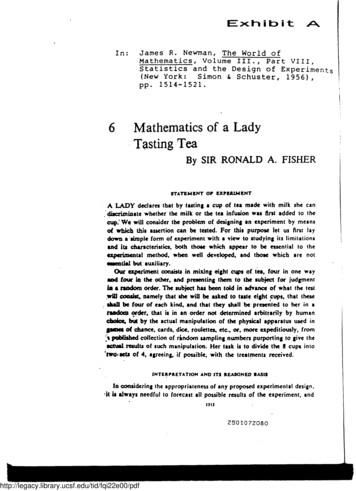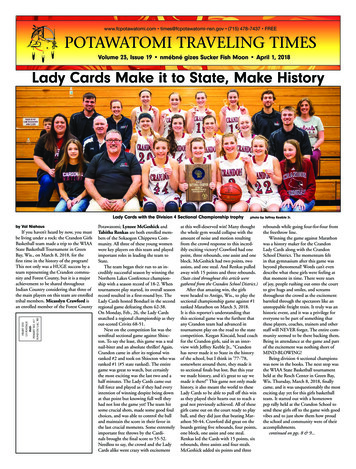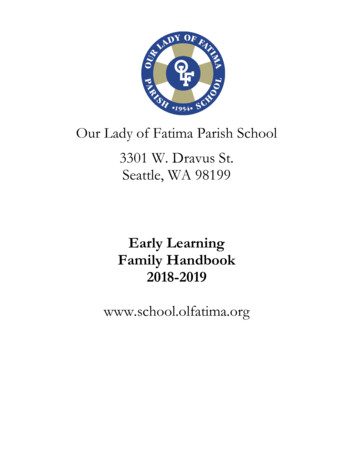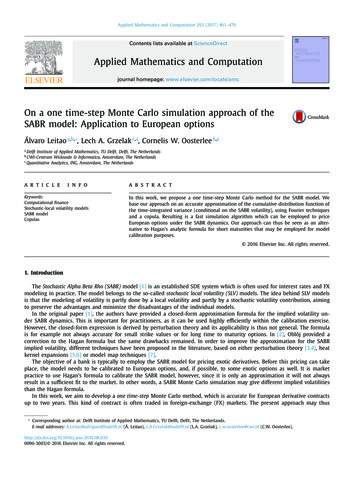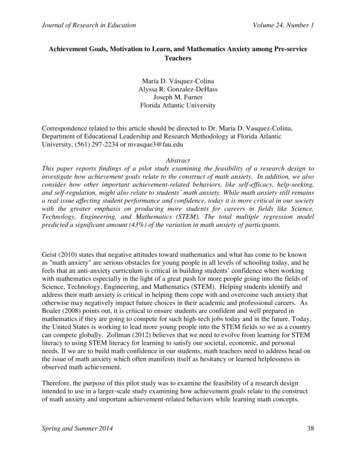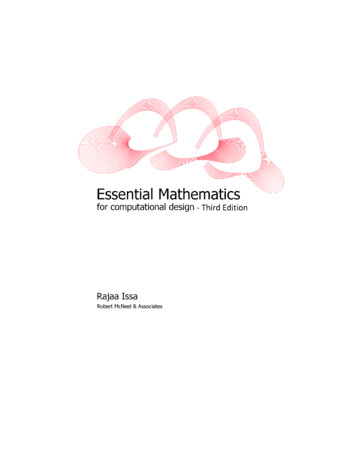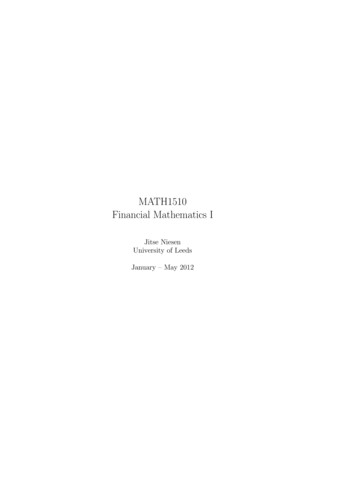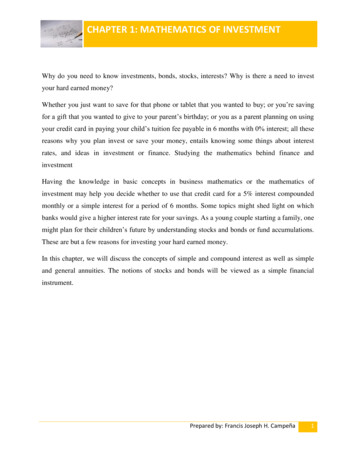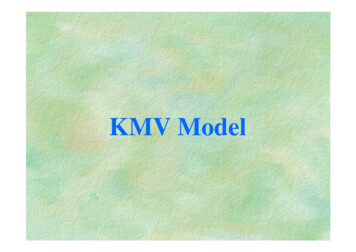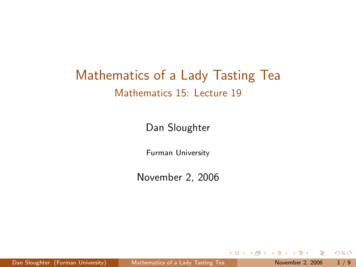
Transcription
Mathematics of a Lady Tasting TeaMathematics 15: Lecture 19Dan SloughterFurman UniversityNovember 2, 2006Dan Sloughter (Furman University)Mathematics of a Lady Tasting TeaNovember 2, 20061/9
Ronald Aylmer FisherI1890 - 1962Dan Sloughter (Furman University)Mathematics of a Lady Tasting TeaNovember 2, 20062/9
Ronald Aylmer FisherI1890 - 1962ITwo classic books on statistics: Statistical Methods for ResearchWorkers, first published in 1925, and The Design of Experiments, firstpublished in 1935Dan Sloughter (Furman University)Mathematics of a Lady Tasting TeaNovember 2, 20062/9
Ronald Aylmer FisherI1890 - 1962ITwo classic books on statistics: Statistical Methods for ResearchWorkers, first published in 1925, and The Design of Experiments, firstpublished in 1935IEqually famous as a geneticist (for example, the text The GeneticalTheory of Natural Selection)Dan Sloughter (Furman University)Mathematics of a Lady Tasting TeaNovember 2, 20062/9
Ronald Aylmer FisherI1890 - 1962ITwo classic books on statistics: Statistical Methods for ResearchWorkers, first published in 1925, and The Design of Experiments, firstpublished in 1935IEqually famous as a geneticist (for example, the text The GeneticalTheory of Natural Selection)IRefused a prestigious position in London to pursue statisticalproblems in agriculture at Rothamsted, where he developed, amongmany other fundamental notions of modern statistics, the theory ofrandomized experimental designDan Sloughter (Furman University)Mathematics of a Lady Tasting TeaNovember 2, 20062/9
The experimentIGiven a cup of tea with milk, a lady claims she can discriminate as towhether milk or tea was first added to the cup.Dan Sloughter (Furman University)Mathematics of a Lady Tasting TeaNovember 2, 20063/9
The experimentIGiven a cup of tea with milk, a lady claims she can discriminate as towhether milk or tea was first added to the cup.ITo test her claim, eight cups of tea are prepared, four of which havethe milk added first and four of which have the tea added first.Dan Sloughter (Furman University)Mathematics of a Lady Tasting TeaNovember 2, 20063/9
The experimentIGiven a cup of tea with milk, a lady claims she can discriminate as towhether milk or tea was first added to the cup.ITo test her claim, eight cups of tea are prepared, four of which havethe milk added first and four of which have the tea added first.IQuestion: How many cups does she have to correctly identify toconvince us of her ability?Dan Sloughter (Furman University)Mathematics of a Lady Tasting TeaNovember 2, 20063/9
Choosing subsetsIThere are 8 7 6 5 1680 ways to choose a first cup, a secondcup, a third cup, and a fourth cup, in order.Dan Sloughter (Furman University)Mathematics of a Lady Tasting TeaNovember 2, 20064/9
Choosing subsetsIThere are 8 7 6 5 1680 ways to choose a first cup, a secondcup, a third cup, and a fourth cup, in order.IThere are 4 3 2 1 24 ways to order four cups.Dan Sloughter (Furman University)Mathematics of a Lady Tasting TeaNovember 2, 20064/9
Choosing subsetsIThere are 8 7 6 5 1680 ways to choose a first cup, a secondcup, a third cup, and a fourth cup, in order.IThere are 4 3 2 1 24 ways to order four cups.ISo the number of ways to choose 4 cups out of 8 is1680 70.24Dan Sloughter (Furman University)Mathematics of a Lady Tasting TeaNovember 2, 20064/9
Choosing subsetsIThere are 8 7 6 5 1680 ways to choose a first cup, a secondcup, a third cup, and a fourth cup, in order.IThere are 4 3 2 1 24 ways to order four cups.ISo the number of ways to choose 4 cups out of 8 is1680 70.24INote: the lady performs the experiment by selecting 4 cups, say, theones she claims to have had the tea poured first.Dan Sloughter (Furman University)Mathematics of a Lady Tasting TeaNovember 2, 20064/9
Choosing subsetsIThere are 8 7 6 5 1680 ways to choose a first cup, a secondcup, a third cup, and a fourth cup, in order.IThere are 4 3 2 1 24 ways to order four cups.ISo the number of ways to choose 4 cups out of 8 is1680 70.24INote: the lady performs the experiment by selecting 4 cups, say, theones she claims to have had the tea poured first.IFor example, the probability that she would correctly identify all 41cups is 70.Dan Sloughter (Furman University)Mathematics of a Lady Tasting TeaNovember 2, 20064/9
Choosing 3ITo get exactly 3 right, and, hence, 1 wrong, she would first have tochoose 3 from the 4 correct ones.Dan Sloughter (Furman University)Mathematics of a Lady Tasting TeaNovember 2, 20065/9
Choosing 3ITo get exactly 3 right, and, hence, 1 wrong, she would first have tochoose 3 from the 4 correct ones.IShe can do this 4 3 2 24 ways with order.Dan Sloughter (Furman University)Mathematics of a Lady Tasting TeaNovember 2, 20065/9
Choosing 3ITo get exactly 3 right, and, hence, 1 wrong, she would first have tochoose 3 from the 4 correct ones.IIShe can do this 4 3 2 24 ways with order.Since 3 cups can be ordered in 3 2 6 ways, there are 4 ways for herto choose the 3 correctly.Dan Sloughter (Furman University)Mathematics of a Lady Tasting TeaNovember 2, 20065/9
Choosing 3ITo get exactly 3 right, and, hence, 1 wrong, she would first have tochoose 3 from the 4 correct ones.IIIShe can do this 4 3 2 24 ways with order.Since 3 cups can be ordered in 3 2 6 ways, there are 4 ways for herto choose the 3 correctly.Since she can now choose the 1 incorrect cup 4 ways, there are a totalof 4 4 16 ways for her to choose exactly 3 right and 1 wrong.Dan Sloughter (Furman University)Mathematics of a Lady Tasting TeaNovember 2, 20065/9
Choosing 3ITo get exactly 3 right, and, hence, 1 wrong, she would first have tochoose 3 from the 4 correct ones.IIShe can do this 4 3 2 24 ways with order.Since 3 cups can be ordered in 3 2 6 ways, there are 4 ways for herto choose the 3 correctly.ISince she can now choose the 1 incorrect cup 4 ways, there are a totalof 4 4 16 ways for her to choose exactly 3 right and 1 wrong.IHence the probability that she chooses exactly 3 correctly isDan Sloughter (Furman University)Mathematics of a Lady Tasting Tea1670 November 2, 2006835 .5/9
Statistical significanceISuppose the lady correctly identifies all 4 cups.Dan Sloughter (Furman University)Mathematics of a Lady Tasting TeaNovember 2, 20066/9
Statistical significanceIISuppose the lady correctly identifies all 4 cups.ConclusionDan Sloughter (Furman University)Mathematics of a Lady Tasting TeaNovember 2, 20066/9
Statistical significanceIISuppose the lady correctly identifies all 4 cups.ConclusionIEither she has no ability, and has chosen the correct 4 cups purely bychance, orDan Sloughter (Furman University)Mathematics of a Lady Tasting TeaNovember 2, 20066/9
Statistical significanceIISuppose the lady correctly identifies all 4 cups.ConclusionIIEither she has no ability, and has chosen the correct 4 cups purely bychance, orshe has the discriminatory ability she claims.Dan Sloughter (Furman University)Mathematics of a Lady Tasting TeaNovember 2, 20066/9
Statistical significanceIISuppose the lady correctly identifies all 4 cups.ConclusionIIIEither she has no ability, and has chosen the correct 4 cups purely bychance, orshe has the discriminatory ability she claims.Since choosing correctly is highly unlikely in the first case (one chancein seventy), we decide for the second.Dan Sloughter (Furman University)Mathematics of a Lady Tasting TeaNovember 2, 20066/9
Statistical significanceIISuppose the lady correctly identifies all 4 cups.ConclusionIIEither she has no ability, and has chosen the correct 4 cups purely bychance, orshe has the discriminatory ability she claims.ISince choosing correctly is highly unlikely in the first case (one chancein seventy), we decide for the second.INote: if she got 3 correct and 1 wrong, this would be evidence for herability, but not persuasive evidence since the chance of getting 3 or17more correct is 70 0.2429.Dan Sloughter (Furman University)Mathematics of a Lady Tasting TeaNovember 2, 20066/9
Statistical significanceIISuppose the lady correctly identifies all 4 cups.ConclusionIIEither she has no ability, and has chosen the correct 4 cups purely bychance, orshe has the discriminatory ability she claims.ISince choosing correctly is highly unlikely in the first case (one chancein seventy), we decide for the second.INote: if she got 3 correct and 1 wrong, this would be evidence for herability, but not persuasive evidence since the chance of getting 3 or17more correct is 70 0.2429.INote: typically, a result is considered statistically significant if theprobability of its occurrence is less than 0.05, that is, less than 1 outof 20.Dan Sloughter (Furman University)Mathematics of a Lady Tasting TeaNovember 2, 20066/9
The null hypothesisIThe null hypothesis is a specific description of a possible state ofnature.Dan Sloughter (Furman University)Mathematics of a Lady Tasting TeaNovember 2, 20067/9
The null hypothesisIThe null hypothesis is a specific description of a possible state ofnature.IIn this example, the null hypothesis is the hypothesis that the ladyhas no special ability to discriminate between the cups of tea.Dan Sloughter (Furman University)Mathematics of a Lady Tasting TeaNovember 2, 20067/9
The null hypothesisIThe null hypothesis is a specific description of a possible state ofnature.IIn this example, the null hypothesis is the hypothesis that the ladyhas no special ability to discriminate between the cups of tea.INote: we can never prove the null hypothesis, but the data mayprovide evidence to reject it.Dan Sloughter (Furman University)Mathematics of a Lady Tasting TeaNovember 2, 20067/9
The null hypothesisIThe null hypothesis is a specific description of a possible state ofnature.IIn this example, the null hypothesis is the hypothesis that the ladyhas no special ability to discriminate between the cups of tea.INote: we can never prove the null hypothesis, but the data mayprovide evidence to reject it.INote: in most situations, rejecting the null hypothesis is what wehope to do.Dan Sloughter (Furman University)Mathematics of a Lady Tasting TeaNovember 2, 20067/9
RandomizationIIt is randomization which allows us to make the probabilitycalculations which reveal whether the data are significant or not.Dan Sloughter (Furman University)Mathematics of a Lady Tasting TeaNovember 2, 20068/9
RandomizationIIt is randomization which allows us to make the probabilitycalculations which reveal whether the data are significant or not.IRandomization takes care of all the possible causes for which wecannot control.Dan Sloughter (Furman University)Mathematics of a Lady Tasting TeaNovember 2, 20068/9
Problems1. Suppose the lady samples 10 cups of tea, among which 5 had the teapoured first and 5 had the milk poured first.a. What is the probability she correctly identifies all five cups which had thetea poured first?b. What is the probability she correctly identifies exactly four of the cupswhich had the tea poured first?c. What is the probability she correctly identifies four or more of the cupswhich had the tea poured first?d. Would we reject the null hypothesis if she correctly identified exactly fourof the cups which had the tea poured first?Dan Sloughter (Furman University)Mathematics of a Lady Tasting TeaNovember 2, 20069/9
I To test her claim, eight cups of tea are prepared, four of which have the milk added first and four of which have the tea added first. I Question: How many cups does she have to correctly identify to convince us of her ability? Dan Sloughter (Furman University) Mathematics of a Lady Tast
